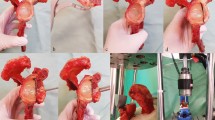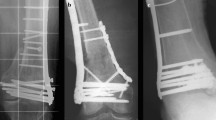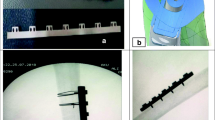Abstract
Objective
External fixators are important for correcting length discrepancies and axis deformities in pediatric or trauma orthopedic surgery. Pin loosening is a common pitfall during therapy that can lead to pain, infection, and necessary revisions. This study aims to present clinical data using calcium titanate (CaTiO3) Schanz screws and to measure the fixation strength.
Patients and methods
22 titanate screws were used for external fixators in 4 pediatric patients. Therapy was initiated to lengthen or correct axial deformities after congenital abnormalities. The maximum tightening torque was measured during implantation, and the loosening torque was measured during explantation. In addition, screws of the same type were used in a cadaver study and compared with stainless steel and hydroxyapatite-coated screws. 12 screws of each type were inserted in four tibias, and the loosening and tightening torque was documented.
Results
The fixation index in the in vivo measurement showed a significant increase between screw insertion and extraction in three of the four patients. The pins were in situ for 91 to 150 days, and the torque increased significantly (P = 0.0004) from insertion to extraction. The cadaveric study showed lower extraction torques than insertion torques, as expected in this setting. The calculated fixation index was significantly higher in the CaTiO3 group than in the other groups (P = 0.0208 vs. HA and P < 0.0001 vs. steel) and in the HA group vs. plain steel group (P = 0.0448).
Conclusion
The calcium titanate screws showed favorable fixation strength compared to HA and stainless steel screws and should be considered in long-term therapy of external fixation.








Similar content being viewed by others
References
Ceroni D, Grumetz C, Desvachez O, Pusateri S, Dunand P, Samara E. From prevention of pin-tract infection to treatment of osteomyelitis during paediatric external fixation. J Child Orthop 2016;10:605–12.
Moroni A, Pegreffi F, Cadossi M, Hoang-Kim A, Lio V, Giannini S. Hydroxyapatite-coated external fixation pins. Expert Rev Med Devices. 2005;2:465–71.
Moroni A, Aspenberg P, Toksvig-Larsen S, Falzarano G, Giannini S. Enhanced fixation with hydroxyapatite coated pins. Clin Orthop 1998;346:171–7.
Moroni A, Heikkila J, Magyar G, Toksvig-Larsen S, Giannini S. Fixation strength and pin tract infection of hydroxyapatite-coated tapered pins. Clin Orthop 2001;388:209–17.
Saithna A. The influence of hydroxyapatite coating of external fixator pins on pin loosening and pin track infection: a systematic review. Injury. 2010;41:128–32.
Coathup MJ, Blunn GW, Flynn N, Williams C, Thomas NP. A comparison of bone remodelling around hydroxyapatite-coated, porous-coated and grit-blasted hip replacements retrieved at post-mortem. J Bone Joint Surg Br 2001;83:118–23.
Reikerås O. Femoral revision surgery using a fully hydroxyapatite-coated stem: a cohort study of twenty two to twenty seven years. Int Orthop 2017;41:271–5.
Collier JP, Surprenant VA, Mayor MB, Wrona M, Jensen RE, Surprenant HP. Loss of hydroxyapatite coating on retrieved, total hip components. J Arthroplast 1993;8:389–93.
Kokubo T, Yamaguchi S. Novel bioactive titanate layers formed on Ti metal and its alloys by chemical treatments. Materials. 2009;3:48–63.
Placzek R, Ruffer M, Deuretzbacher G, Heijens E, Meiss AL. The fixation strength of hydroxyapatite-coated Schanz screws and standard stainless steel Schanz screws in lower extremity lengthening: a comparison based on a new torque value index: the fixation index. Arch Orthop Trauma Surg 2006;126:369–73.
Checketts RG, MacEachem AG, Otterbum M. Pin track infection and the principles of pin site care. In: De Bastiani G, Apley AG, Goldberg A, (eds) Orthofix external fixation in trauma and orthopaedics. London: Springer London; 2000. http://link.springer.com/10.1007/978-1-4471-0691-3_11.
Hedin H, Larsson S. Technique and considerations when using external fixation as a standard treatment of femoral fractures in children. Injury. 2004;35:1255–63.
Kazmers NH, Fragomen AT, Rozbruch SR. Prevention of pin site infection in external fixation: a review of the literature. Strateg Trauma Limb Reconstr Online. 2016;11:75–85.
Kizuki T, Matsushita T, Kokubo T. Antibacterial and bioactive calcium titanate layers formed on Ti metal and its alloys. J Mater Sci Mater Med 2014;25:1737–46.
Coreño J, Coreño O. Evaluation of calcium titanate as apatite growth promoter. J Biomed Mater Res A 2005;75:478–84.
Haenle M, Lindner T, Ellenrieder M, Willfahrt M, Schell H, Mittelmeier W, et al. Bony integration of titanium implants with a novel bioactive calcium titanate (Ca4Ti3O10) surface treatment in a rabbit model. J Biomed Mater Res A. 2012;100:2710–6.
Braem A, Chaudhari A, Vivan Cardoso M, Schrooten J, Duyck J, Vleugels J. Peri- and intra-implant bone response to microporous Ti coatings with surface modification. Acta Biomater 2014;10:986–95.
Placzek R, Hempfing A, Meiss AL. Evaluation of hydroxyapatite-coated Schanz screws in the Heidelberg external fixation system (HEFS). Biomed Tech. 2001;46:172–5.
Ktistakis I, Guerado E, Giannoudis PV. Pin-site care: can we reduce the incidence of infections? Injury. 2015;46:S35–9.
DeJong ES, DeBerardino TM, Brooks DE, Nelson BJ, Campbell AA, Bottoni CR, et al. Antimicrobial efficacy of external fixator pins coated with a lipid stabilized hydroxyapatite/chlorhexidine complex to prevent pin tract infection in a goat model. J Trauma. 2001;50:1008–14.
Hosny G, Fadel M. Ilizarov external fixator for open fractures of the tibial shaft. Int Orthop 2003;27:303–6.
Parameswaran AD, Roberts CS, Seligson D, Voor M. Pin tract infection with contemporary external fixation: how much of a problem? J Orthop Trauma. 2003;17:503–7.
Britten S, Ghoz A, Duffield B, Giannoudis PV. Ilizarov fixator pin site care: the role of crusts in the prevention of infection. Injury. 2013;44:1275–8.
Davies R, Holt N, Nayagam S. The care of pin sites with external fixation. J Bone Jt Surg Br 2005;87:716–9.
Sian PS, Britten S, Duffield B. The care of pin sites with external fixation. J Bone Jt Surg Br 2006;88:558.
Lethaby A, Temple J, Santy-Tomlinson J. Pin site care for preventing infections associated with external bone fixators and pins. Cochrane Database Syst Rev. 2013;12:CD004551.
Hohloch L, Konstantinidis L, Wagner FC, Strohm PC, Südkamp NP, Reising K. Biomechanical evaluation of a new technique for external fixation of unstable supracondylar humerus fractures in children. Technol Health Care J Eur Soc Eng Med 2015;23:453–61.
Hohloch L, Konstantinidis L, Wagner FC, Strohm PC, Südkamp NP, Reising K. Biomechanical comparison of different external fixator configurations for stabilization of supracondylar humerus fractures in children. Clin Biomech Bristol Avon. 2016;32:118–23.
Li W-C, Meng Q-X, Xu R-J, Cai G, Chen H, Li H-J. Biomechanical analysis between Orthofix® external fixator and different K-wire configurations for pediatric supracondylar humerus fractures. J Orthop Surg 2018;13:188.
Grubor P, Grubor M, Asotic M. Comparison of stability of different types of external fixation. Med Arh 2011;65:157–9.
Shirai T, Watanabe K, Matsubara H, Nomura I, Fujiwara H, Arai Y, et al. Prevention of pin tract infection with iodine-supported titanium pins, J. Orthop. Sci. J Jpn Orthop Assoc 2014;19:598–602.
Collinge CA, Goll G, Seligson D, Easley KJ. Pin tract infections: silver vs uncoated pins. Orthopedics. 1994;17:445–8.
Moroni A, Vannini F, Mosca M, Giannini S. State of the art review: techniques to avoid pin loosening and infection in external fixation. J Orthop Trauma. 2002;16:189–95.
Manley MT, Hurst L, Hindes R, Dee R, Chiang FP. Effects of low-modulus coatings on pin-bone contact stresses in external fixation. J Orthop Res Publ Orthop Res Soc 1984;2:385–92.
Voos K, Rosenberg B, Fagrhi M, Seligson D. Use of a tobramycin-impregnated polymethylmethacrylate pin sleeve for the prevention of pin-tract infection in goats. J Orthop Trauma. 1999;13:98–101.
Lawes TJ, Scott JCR, Goodship AE. Increased insertion torque delays pin-bone interface loosening in external fixation with tapered bone screws. J Orthop Trauma. 2004;18:617–22.
Pettine KA, Chao EY, Kelly PJ. Analfysis of the external fixator pin-bone interface. Clin Orthop 1993;293:18–27.
Aro HT, Markel MD, Chao EY. Cortical bone reactions at the interface of external fixation half-pins under different loading conditions. J Trauma. 1993;35:776–85.
Author information
Authors and Affiliations
Corresponding author
Ethics declarations
Conflict of interest
The authors declare that they have no conflict of interest.
Additional information
Publisher’s note Springer Nature remains neutral with regard to jurisdictional claims in published maps and institutional affiliations.
Rights and permissions
About this article
Cite this article
Gathen, M., Ploeger, M.M., Jaenisch, M. et al. Outcome evaluation of new calcium titanate schanz-screws for external fixators. First clinical results and cadaver studies. J Mater Sci: Mater Med 30, 124 (2019). https://doi.org/10.1007/s10856-019-6325-8
Received:
Accepted:
Published:
DOI: https://doi.org/10.1007/s10856-019-6325-8




